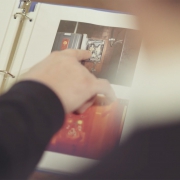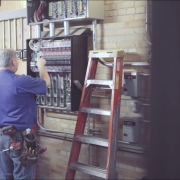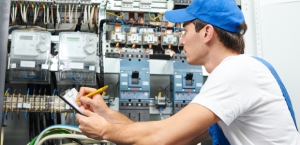Cost Saving Solutions & Commercial Buildings
Quick fixes
Many large office buildings can benefit from quick low-cost/no-cost energy-saving solutions, such as turning things off, turning things down, and keeping up with cleaning and maintenance.
Turning things off
Turning things off seems simple, but remember that for every 1,000 kWh that you save by turning things off, you save $100 on your utility bill (assuming average electricity costs of 10 cents per kWh).
Computers and Monitors
Computers and other electronic equipment are ubiquitous in large office buildings and can contribute up to 20% of overall energy consumption. You can gain significant energy savings by verifying that computer power-management settings are enabled on individual computers and monitors, forcing them to enter sleep mode after a specified period of inactivity. Effective power management settings can cut a computer’s electricity use roughly in half, saving up to $75 annually per computer. Although most computers are now shipped with some sort of power management settings enabled, they may be disabled or made less effective by users or internal IT, and can often be made more rigorous to maximize energy savings. For more information, the US Environmental Protection Agency (EPA) offers detailed instructions on Energy Star’s The Business Case for Power Management page. Some users may be concerned that automatic software updates will be inhibited if power management settings are enabled, but that’s not the case; updates can automatically begin to download when the computer awakens from sleep mode.
Other office equipment and plug loads
Like computers, devices such as printers, fax machines, and coffeemakers often have energy-reduction settings that can yield substantial energy savings. Additionally, consider supplying employees with smart power strips with occupancy sensors, which are an easy way to shut off their often-forgotten energy users such as personal printers, monitors, desk lamps, radios, clocks.
Lights
Lights should be turned off when not in use, but many people forget to take this step. When properly installed, occupancy sensors and timers can do this for you. A no-cost option is to simply train staff to turn off lights as part of their closing procedures (you can also help by posting a notice that identifies the locations of light switches).
Space heaters
Space heaters are energy hogs, drawing 1 kilowatt (kW) or more of power. As a first step, plug heaters into power strips controlled by occupancy sensors (other loads such as task lights and monitors can also be plugged into the power strips). Also recognize that the perceived need for individual space heating usually indicates poor HVAC system control.
Chilled-water drinking fountains and water coolers
Water fountains generally don’t need to provide ice-cold water 24 hours a day unless it’s required for health reasons. In most cases, you can turn off the cooling systems in drinking fountains. Likewise, water coolers generally don’t need to need to be turned on 24 hours a day. The average office water cooler consumes about 800 kWh per year. Because much of this energy is from standby losses, a simple method of cutting energy waste is to attach a timer. Programming an office water cooler to only operate for 10 hours a day, 5 days a week, can significantly reduce its energy waste. In addition, when it’s time to replace old coolers, choosing an Energy Star–qualified model can yield large savings over standard models because they have thicker insulation, more efficient cooling systems, and other efficiency-boosting features.
Vending machines
Refrigerated vending machines typically operate 24/7, using 2,500 to 4,400 kWh per year and adding to cooling loads in the spaces they occupy. Timers or occupancy sensors can yield significant savings because they allow the machines to turn on only when a customer is present or when the compressor must run to maintain the product at the desired temperature.
Turning things down
Some equipment cannot be turned off entirely but can be turned down to save energy.
HVAC temperature setbacks
During closed hours, turn temperature settings down in warming seasons and up in cooling seasons. Programmable thermostats make temperature setbacks a reliable option.
Peripheral and back rooms
Make sure that HVAC settings in stockrooms, rarely used offices, and other peripheral rooms are at minimum settings.
Window shades and blinds
During warm weather, blinds can block direct sunlight and reduce cooling needs; in the winter, opening the blinds on south-facing windows will let in sunlight to help heat the space.
Building automation systems tuning
For office buildings that already have a building automation system (BAS), make sure that temperature setbacks are coordinated with building occupancy on a quarterly basis. Facility engineers can align the HVAC schedules in the BAS with expected occupancy to optimize energy usage. Identify buildings that are not used at night, on weekends, or for long periods of time (such as during holiday breaks), and adjust temperature settings in those locations. Also, check that HVAC systems are not set to overcool or overheat the building. For facilities with regular occupancy schedules but without a BAS, programmable thermostats can make temperature setbacks a reliable option. The benefits of installing a BAS in a facility without one are further discussed in Longer-Term Solutions.
–
Excerpt from Orlando Utility Commission (01.16.2018)







